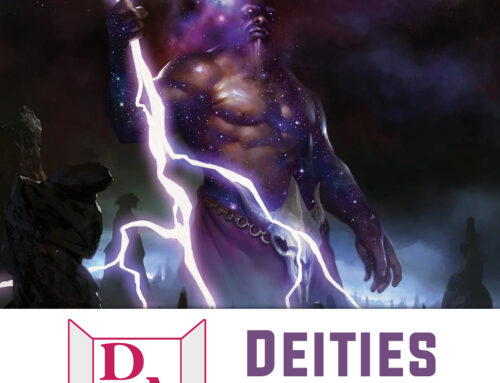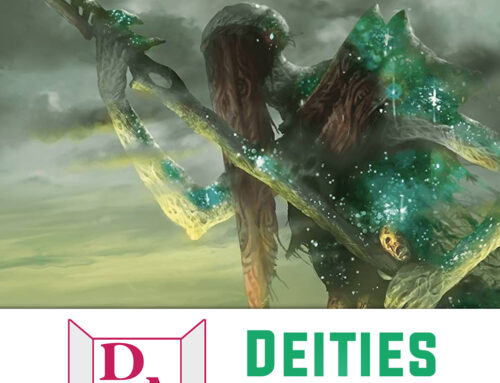What is the Tone of a Game?
The tone can be described as the general atmosphere of the adventure, story, or setting that your game is taking place in. All of the settings of D&D have recurring themes that help set the stage for your game.
Dark Sun is a setting that evokes the tones of a dying world ravaged by avarice and the folly of man. The gods have abandoned this world, and arcane tyrants rule it with an iron fist; their magic draining away what little life remains in this barren wasteland.
Ebberon is a world where science meets magic, and five major nations work against each other in a cold war of politics and arms racing. It is a world of high adventure or noir mystery. It is a setting of competing factions, whether it’s great nations or the Dragonmarked Houses.
Ravenloft is the epitome of gothic horror with its dark ironies and grim mystique. It is where bloody tragedies unfold and it is impossible to distinguish man from monster.
Each of these settings plays with different themes, and helps tell different stories. These themes can set the tone for the game you want to run, or you can buck these trends and play off them. Take Batman, for example: depending on which comic series you read or which cartoon or movie you watch, you can have a dark gritty thriller or a light hearted romp with the Scooby Gang. What’s important is that you make your game consistent, and make sure your players understand what tone the game is going to be. This sets the expectations the players will have of the game, and helps players make decisions for their characters.
Setting Expectations
Establishing the tone early is very important, even before the first game session; starting as early as character creation. If you want to tell a noir detective story in the grand metropolis of Sharn, then your players need to know that so they can make an informed decision. Instead of bringing their illiterate, wilderness tracker, barbarian of the wastes, they can pull out their forensics-focused alchemist gnome. Talking to your players is key. Too many times I’ve shown up to a table without the play group talking things through and someone (myself included) brought a character to the that was ill suited for the story we were going to tell. Roleplay becomes choppy, and immersion in the game begins to fall apart.
Quick Sidebar: While thinking hard about the tone of your game can do a lot to up the RP part of your rpg, it’s not what everyone is looking for. D&D is supposed to be fun, and if you want your game to be a relaxed space where you and your friends just get together and hangout, or you want to focus more on the combat strategy aspects of the game, that’s awesome, and all the power to you.
Crafting the Scene
After you’ve decided on what the tone is, and your players are on the same page, you need to look at the tools at your disposal: descriptions, NPCs & monsters, and mechanics.
Fighting men and monsters is one of the core parts of D&D, it’s what most of the mechanics of the game is focused on. The foes they meet, and how they’re presented will have a significant effect on the atmosphere of the game. Take the humble goblin for example. Arguably one the most iconic monsters in the game’s history and one of the most versatile. In a light hearted adventure they can be a great source of comic relief, bumbling around as knitwits that are more of a danger to themselves than the local farmlands, or they can be a terrifying menace, burning down farmhouse, killing pets and livestock, and roasting people on a spit.
How you describe the world around your players can be a great way to get them in the right mindset. This helps establish what they can expect from the dungeon, tavern, or terrain.
“Damp cloaks hang from pegs in the entrance portico. The tavern is packed with tables and chairs, with narrow paths meandering between them. A bar stretches along one wall, under a balcony that can be reached by a wooden staircase that hugs the north wall. Another balcony overhangs an entrance to the east. All the windows are fitted with thick shutters and crossbars. Lanterns hanging above the bar and resting on the tables bathe the room in dull orange light and cast shadows upon the walls, most of which are adorned with wolf heads mounted on wooden plaques.” – Curse of Strahd
This is one of the first inns the players will come across in the dread lands of Barovia on the demiplane of Ravenloft. A cramp space of dim lights, and long shadows; a small respite for people who live miserable lives, and even here they are surrounded by beasts on all sides. This description is followed by poor food and drink for too high a price. A perfect start to the terrifying journey ahead of them.
Sidebar Again! If you’re unsure of what tones you want to use or how to create the right atmosphere; my best advice: read books, watch movies, and read premade adventures, even if you have no intention of running them. Each one adds more and more to your archive of npcs, story ideas, and locales. Things you can pull out when you need to plan an adventure arch that is made up of the patchwork of the media you’ve consumed. Your players aren’t looking for the next great genre novel, they’re there for fun and to tell a great story.
While roleplay and the description of a world play huge parts in creating the atmosphere of a game, the mechanics of a game can be just as useful to reinforce them. For example, if you are running a game in Dark Sun, a grim dystopian world on a desert wasteland, the scarcity of resources can play a major role in maintaining the tone of the game. I know in a lot of games I’ve run things like daily water and food consumption is often set aside, it’s not always important to micro manage those things in settings where food and drink are abundant. But in the desert world of Athas, whether or not the party has water is a constant matter of life and death. Conflict over water, or the sudden theft or destruction of what they thought was a secure supply can ratchet up the intensity of the moment, and create a sense of immediate doom.
Conclusion
More than classes, spells, and dice rolls, Dungeons and Dragons is about a group telling a story. Knowing what kind of story you want your group to tell. This will help you make decisions on how light to make humor, how dour to make your scene descriptions, the kind of monsters to include and how they are portrayed. There are some many small things that you can do to make a game feel the way you want it to.


